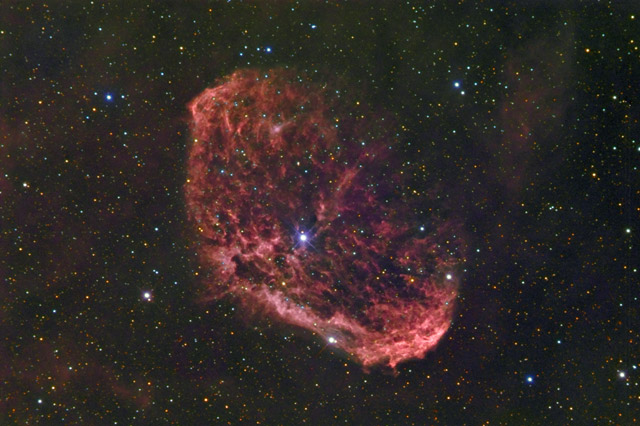
NGC 6888 - THE CRESCENT NEBULA in CYGNUS
|
About this Object: |
|
The Crescent Nebula, NGC 6888, is an interesting nebula with a pecular and unique shape. At the center of the Nebula is a Wolf-Rayet star (WR 136) that shines at magnitude 7.4, a star in the latter part of its life-cycle that is shedding off its mass in the form of a strong, stellar wind. It has shed off all its hydrogen gases leaving its helium core exposed, a dynamic that will result eventually in a supernova explosion. The stellar winds stirred up the surrounding interstellar dust and gas causing ripples across the visible part of the nebula, which is now seen because the ultraviolet radiation of WR136 exciting the gases of the nebula, causing it to fluoresce. Many planetary nebulae have similar Wolf-Rayet Stars at their center. In the case of NGC 6888, it is classified as an emission nebula because it emits its own light, although it shares many characteristics of planetary nebulae itself. The Crescent is quite difficult to observe visually because of its rather even surface illumination. To see it, you'll need medium to large aperture and dark skies. |
Location:
Ballauer Observatory
near Azle, Texas
Date: June 26 & 27, 2005
Seeing:
7/10
Transparency: 3/10
Temperature: 72 degrees F
Scope/Mount: 12.5" RCOS RC and Paramount ME
Camera: SBIG STL-6303e (Ha) and SBIG STL-11000M (RGB) astro
CCD cameras
Filter: Custom Scientific 4.5nm Hydrogen-alpha filter
Exposure Info: HaRGB image - 120:80:50:80 minutes (20 minute
subexposures for Ha; 10 minute subs for RGB; all unbinned)
Processing
Information:
Calibration, Registration, DDP,
and RGB combine in MaxIm DL 4. HaRGB combine, Levels/curves, sharpening,
and noise removal in Photoshop CS.
Extra Notes: H-alpha data blended 50% with the red channel to improve color saturation. H-alpha data was then used again as luminance.
Astronomi Nebula Resimler Astrophotography Galaxy Resimler Yıldız Resimler
Copyright(c) 2003 - 2005 A- Cetinbal - All rights reserved.